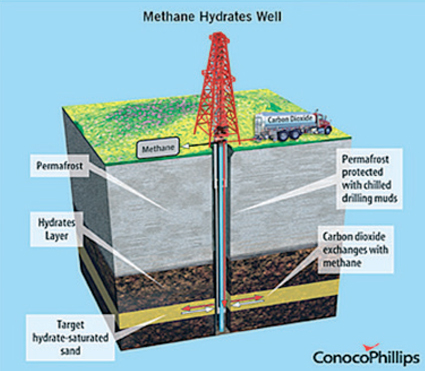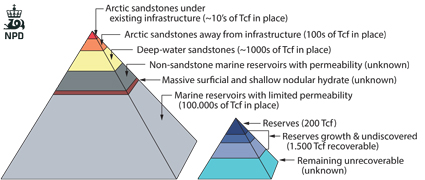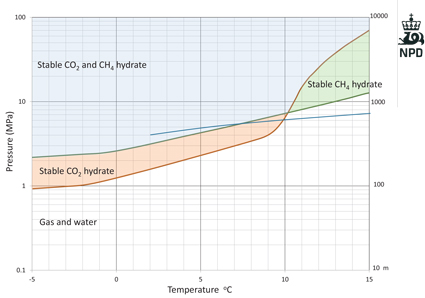2 - Petroleum activity on the Norwegian Continental Shelf
In May 1963, the Norwegian government proclaimed sovereignty over the Norwegian continental shelf (NCS). A new act stipulated that the State was the landowner, and that only the King (Government) could grant licences for exploration and production. Licences on the NCS are awarded in mature areas during APA (Awards in Predefined Areas) or during ordinary licensing rounds in frontier areas. The discovery of the Ekofisk field in 1969 started the Norwegian oil and gas adventure, and production from the field began 15 June 1971. During the following years, several large discoveries were made in the North Sea. In the 1970s exploration activity was concentrated in this area, but gradually expanded northwards during the 1980s. Only a limited number of blocks were announced for each licensing round, and the most promising areas were explored first. This led to world class discoveries.
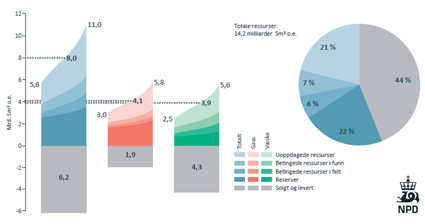
Fig.2.01
Petroleum resources and uncertainty in the estimates for
the Norwegian Continental Shelf per 31.12.2013.
(Source: Norwegian Petroleum Directorate)
Currently, 78 fields are in production on the Norwegian continental shelf (NCS). In addition, there are 12 abandoned fields, all in the North Sea. Production from the North Sea has been dominated by large fields such as Ekofisk, Statfjord, Oseberg, Gullfaks and Troll. These fields have been, and still are, very important for the development of petroleum activities in Norway. The large field developments have led to the establishment of infrastructure, enabling tie-in of a number of other fields. Current production and future opportunities in the southern part of the North Sea are linked to the chalk reservoirs in this area. The area is a mature petroleum province, and the majority of today’s production comes from the Ekofisk, Eldfisk, Tor, Valhall and Hod chalk fields. Together, these fields still contain very significant oil volumes. Some chalk fields in the area have been shut down, and some discoveries are not yet developed.
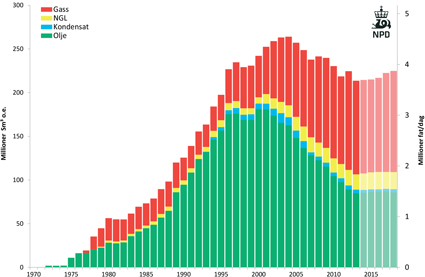
Fig.2.02
Historical petroleum production of oil and gas,
and prognosis for production in coming years
(Source: Norwegian Petroleum Directorate)
The central part of the North Sea also has a long history of petroleum activity, and here discoveries have been made in several types of petroleum reservoirs. The first development in the area was the Frigg gas field, which produced for 27 years before it was shut down in 2004. At the Utsira High, which is considered a mature exploration area, new types of reservoirs have also been discovered during the last couple of years. These discoveries will be developed together under the name of the Johan Sverdrup field. This field might contain so much oil that it enters the top 10 list of discoveries on the NCS and might prove the biggest discovery here since the 1980s. The Sleipner field is an important hub for the Norwegian gas transport system, as both UK and the Continental Europe can be reached. In addition, this field has facilities designed to reduce the CO2 content of the gas. For nearly 18 years, CO2 extracted from the Sleipner Vest well stream has been stored under the seabed, yielding important experience and knowledge about subsurface storage of CO2. Oil and gas have been produced in the northern part of the North Sea since the late 1970s. There are significant remaining reserves and resources in the area, both in fields and discoveries. The northern part of the North Sea consists of several petroleum provinces: with fields like Statfjord, Gullfaks, Snorre, Oseberg and Troll.
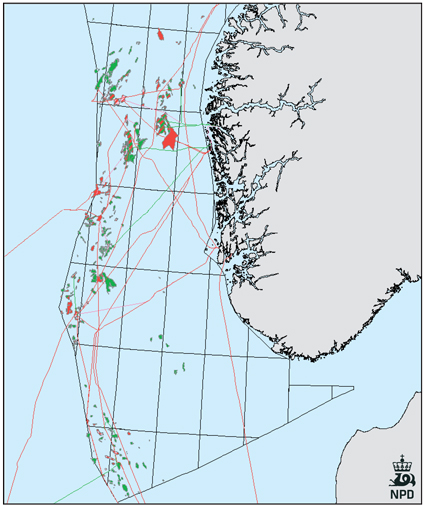
Fig.2.03
Norwegian North Sea, fields and discoveries (red= gas, green= oil), per March 2014.
The Norwegian North Sea was opened for exploration activity in 1980, and the first field in the area to commence production was Draugen in 1993. A number of fields have since been developed. Several smaller fields that are located around existing infrastructure have been put into production in recent years. Today, the Haltenbanken area and Ormen Lange field are mature areas with considerable oil and gas production along with well-developed infrastructure. There are also areas in the Norwegian Sea that have not yet been developed or even opened up for exploration activity. Oil production from the major fields in the area is declining. The gas export capacity from Haltenbanken, through the Åsgard transport system (ATS), is fully booked for several decades into the future. This could affect the timing for phase-in of new discoveries on Haltenbanken. The Norwegian Sea has also been proven to contain significant volumes of gas. Produced gas from the fields is transported through the ATS pipeline to Kårstø in Rogaland County, and in Haltenpipe to Tjeldbergodden in Møre and Romsdal County. The gas from Ormen Lange runs in a pipeline to Nyhamna, which is also in Møre and Romsdal, and further to the United Kingdom. The CO2 content in the gas produced from several of these fields is relatively high, and that is also the case for some other discoveries in the area. Gas from these fields is therefore mixed with gas containing lower amounts of CO2 to achieve compliance with gas quality requirements. The blending takes place from fields both in the Norwegian Sea and from fields located further south. This process creates interdependence between the fields in the Norwegian Sea, and affects how the individual fields are produced. The Vøring area in the Norwegian Sea currently has no infrastructure, but several gas discoveries have been made in the area.
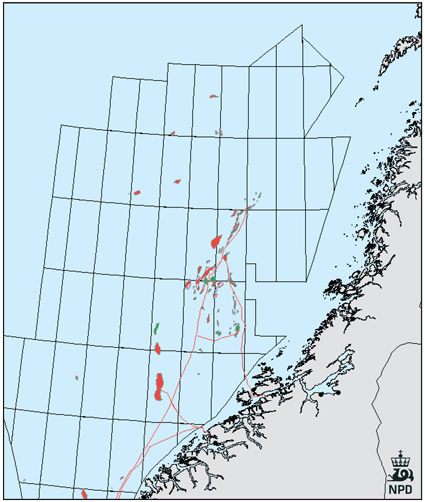
Fig.2.04
Norwegian Sea, fields and discoveries (red= gas, green= oil) per March 2014.
The Barents Sea is part of the Arctic Ocean and is considered an immature petroleum province. The area covers 1.3 million km2, and the water depth varies between 200 and 500m. The southern part of the Barents Sea is in general opened for petroleum activities, with the first licensing round announced in 1979. The first wildcat wells in the Barents Sea were spudded in 1980, and the first discovery was made by the third wildcat, 7120/8-1 Askeladd. The biggest gas discovery is 7121/4-1 Snøhvit, drilled in 1984 with Statoil as operator. The Snøhvit gas field started production in 2007 and is the only field developed so far. The gas from Snøhvit is transported to a land terminal at Melkøya, where it is refrigerated into LNG (liquefied natural gas) and forwarded by ship. As in many gas discoveries in the Norwegian Sea, the CO2 content in the Snøhvit area is high. CO2 is therefore separated from the gas stream onshore on the Melkøya terminal, transported through a 153 km pipeline on the seabed and injected into the Stø formation in the Snøhvit field. The Upper Triassic to Middle Jurassic play in the Hammerfest Basin is the most thoroughly explored play in the Barents Sea. This play has been proved by both the Snøhvit discovery and the Goliat oil field, which is currently under development with Norwegian Eni as operator.
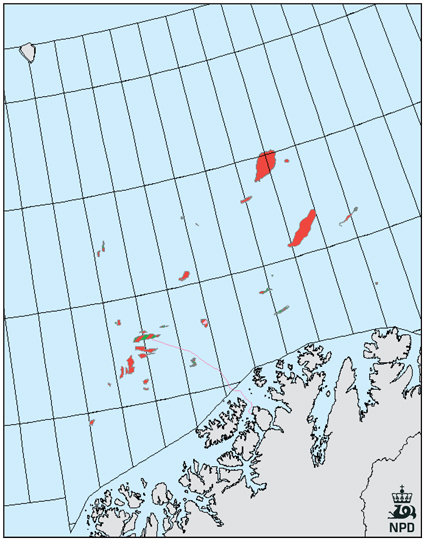
Fig.2.05
Barents Sea, fields and discoveries (red= gas, green= oil) per March 2014.
The Lower to Upper Triassic play on the Bjarmeland Platform is less explored. The first well to test this play was drilled in 1987, and the following five wells were dry. In addition, a couple of discoveries were significantly smaller than expected. Approximately 10 wildcat wells have been drilled and three gas discoveries made, with 7225/3-1 (Norvarg) as the largest. The Norvarg discovery is encouraging, and the estimate of undiscovered resources shows that the play potential remains large. The Upper Triassic to Lower Cretaceous plays along the Ringvassøya-Loppa and Bjørnøyrenna fault complexes are also relatively unexplored, with only about 16 wildcat wells. More than half of these were dry. The first well to test these plays was drilled in 1983, and the first gas discovery, 7019/1-1, was made in 2000. This discovery contained gas with a very high CO2 content.
Today there are 53 active licences in the Barents Sea. Approximately 100 exploration wells have been drilled and they have resulted in about 35 discoveries.
Norway’s gas pipelines have a total length of about 8000 kilometres. The gas flows from production installations to process plants where natural gas liquids are separated out and exported by ship. The remaining dry gas is piped on to receiving terminals in continental Europe and the UK. There are four receiving terminals for Norwegian gas on the Continent; two in Germany, one in Belgium and one in France. In addition, there are two receiving terminals in the UK. Norwegian gas is important for the European energy supply and is exported to all the major consumer countries in Western Europe. Norwegian gas export covers close to 20 per cent of European gas consumption. The transport capacity in the Norwegian pipeline system is currently about 120 billion scm per year.
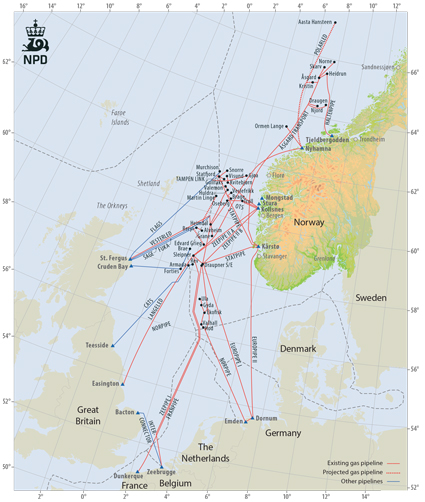
Fig.2.06
Gas pipelines (NPD 2013)
Norway was in 2012 the world’s seventh largest exporter of oil and the third largest exporter of natural gas. Oil production declined after a peak in 2001, but it is expected that future production of oil will be relative stable for some years to come. Gas production has increased steadily since 1995, and the total production on the shelf is expected to stabilize for the next five years. The North Sea is the most mature area on the NCS with regard to petroleum activity. About 615 wells have been drilled, and the geology is well known. Consequently, there is less uncertainty in our estimates of undiscovered resources in the North Sea than in our estimates for the Norwegian Sea or the Barents Sea. As seen from the estimates of undiscovered resources in the NCS, the seabed offshore Norway still hides significant volumes of oil and gas.
The year 2014 marks the 48th anniversary of the arrival of Ocean Traveler in Norway and the spudding of the first well on the Norwegian Continental Shelf (NCS). Since then, the geological knowledge of the shelf has increased greatly. Exploration activity on the NCS is still high, with extensive seismic surveys and a large number of exploration wells. Maintaining a high level of exploration activity will also be necessary in the years to come, in order to clarify the potential of the undiscovered resources and to make new discoveries which can be developed.
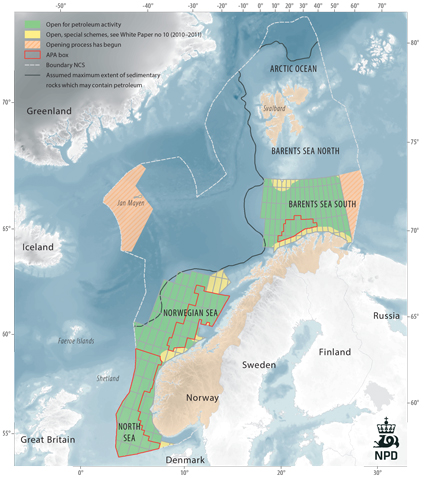
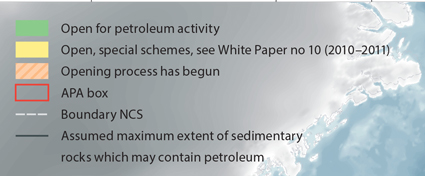
Fig.2.07
Area status for the Norwegian Continental Shelf March 2012
(Source: NPD Facts 2013)
Gas hydrates
Gas hydrates in the Barents Sea
by Rune Mattingsdal, Alexey Deryabin (NPD) and professor Arne Graue (UiB)
Natural gas hydrate is a solid, consisting mostly of methane and water. It form crystals where gas molecules are trapped in cage-like structures formed by water molecules. Gas hydrates can be found in Arctic regions below permafrost and in the marine subsurface at deep water, high pressure conditions and low temperatures (typically above 60 bar and below 100°C). Hydrate is a highly condensed form of natural gas bound with water; one cubic metre of hydrate corresponds to ca. 160 cubic metres of natural gas at atmospheric conditions. The zone where gas hydrates can form is referred to as the gas hydrate stability zone (GHSZ). In the marine environment, the GHSZ is located between the sea floor and the base of the stability zone defined by the phase diagram. The limits of the stability zone are determined by bottom water temperature, sea level, geothermal gradient, gas composition and pore water salinity.
The Barents Sea is a relative deep continental shelf with water depths of up to 500 metres, mainly due to several episodes of glacial erosion. This, combined with bottom water temperatures that can be as low as 0°C or colder, results in a GHSZ thickness which might vary from a few tens of metres to 400 metres, depending on the gas composition and geothermal gradient (Chand et al, 2008). The figure below shows a modelled GHSZ thickness map. Within this zone, gas hydrates can form in areas where there is sufficient flux of thermogenic methane or deposits of biogenic methane. In the southwestern Barents Sea, the thickest GHSZ generally coincide with the deeper parts of the shelf. Here gas hydrates might in theory act as a seal for hydrocarbons in shallow reservoirs. In the Barents Sea, gas hydrates have been drilled in the Vestnesa Ridge area west of Spitsbergen, and there are good geophysical indications of gas hydrates in the Bjørnøya Basin.
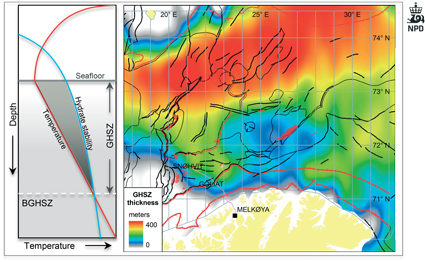
Fig.2.08
Left: Conceptual model of the gas hydrate stability zone (GHSZ) for a marine setting. BGHSZ is the bottom of the GHSZ.
Right: GHSZ thickness map calculated assuming 96% methane + 3% ethane + 1% propane and sea water with a geothermal gradient of 31 °C/km, adapted from Chand et al. (2008). Fields, discoveries, faults and boundaries are indicated.
CO2 storage in hydrates
CO2 may be stored in gas hydrates. Exposing methane hydrate to CO2 will cause a solid exchange of CO2 and CH4 as guest molecules within the hydrate; an exchange caused by the fact that it is thermodynamically more favourable for water to form hydrates with CO2 than with methane. CO2 sequestration in hydrates is a win-win process, since associated natural gas will be produced as CO2 and is sequestered in the form of CO2 hydrates. The regenerated CO2 hydrate is thermodynamically more stable than the methane hydrate; thus the replacement of natural gas hydrate with CO2 hydrate will increase the stability of hydrate formations.
From an energy perspective, natural gas hydrates may represent an enormous energy potential (Boswell and Collett 2006). Some authors claim that the total energy of natural gas entrapped in hydrate reservoirs worldwide might be more than twice the energy of all known coal, oil and gas energy sources. To store CO2 in natural gas hydrate reservoirs by replacing the CH4 in the hydrate with CO2 may become very attractive, compared to other methods of producing natural gas from hydrates. Besides the CO2 storage potential, this method benefits from little or no associated brine production, which has been a severe limitation in previous attempts to produce natural gas from hydrates by depressurization and heat injection. Another benefit is its ability to maintain the geomechanical stability to avoid formation collapse or subsidence. A field pilot in Alaska performed by ConocoPhillips and US DOE in 2012 concluded that CO2 was stored and methane successfully produced during a huff and puff operation injecting 200 000 scf of CO2 and nitrogen.
Storage of CO2 as hydrates below the sea floor is a possible trapping mechanism, but it has not been considered here because the long term behaviour of such hydrates in shallow sediments is not well known. It should be noted that within the gas hydrate stability zone, a seepage of CO2 will be trapped as hydrates before reaching the sea floor.
Fig.2.09
CO2 storage in hydrate formations, as demonstrated in the Alaskan Injection test by ConocoPhillips and USDOE
(Courtesy ConocoPhillips)
Fig.2.10
Boswell, R. and Collett, T.S.:
"The gas hydrate resource pyramid",
Fire in the ice, Netl fall newsletter, 5-7, 2006
Fig.2.11
Phase diagram for water, methane and CO2.
The scale to the right shows app.roximate water depth con- verted from the pressure scale. CO2 hydrate is more stable than methane hydrate at depths shallower than 700 m. The blue line shows pressure and temperature below the sea bed assuming a sea water temperature of 2 °C and a gradient of 40 °C /km.
Fig.2.12
Natural Gas Hydrate on Fire; "Fiery Ice" (Courtesy USGS)
